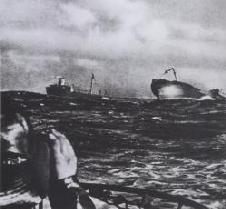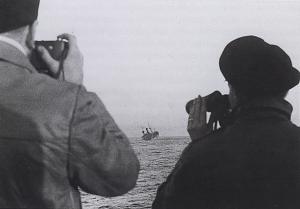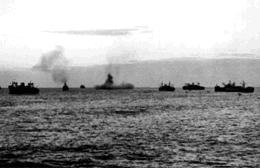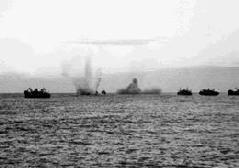

|
U-Boat Wolf Pack Tactic
The Wolf Pack or “Rudeltaktik” as the Germans called it was made famous by Karl Donitz and was to have a devastating impact on allied shipping. Despite being implemented only after the fall of France, the origins of this idea first dated back to the First World War. During the First World War, the British had defeated the U-boats by introducing the convoy system. This called for the formation of a group of ships to sail together as a group and under the protection of escort warships. Under the convoy system, U-boats could no longer find isolated easy targets scattered all over. The few U-boats who managed to find a convoy had difficulty attacking as it was escorted by antisubmarine vessels.

|

|
| Operating in packs, U-boats preyed relentlessy on cargo ships that crossed the Atlantic. In this photograph, a torpedoed merchant goes down on the right, while the U-boat closes in on the second vessel. | OL Gunther Hessler of U-107 torpedoes a steamer off Freetown, Sierra Leone while his 1WO photographs the sinking. |
The wolf pack tactic was devised to defeat the convoy system. As the British had organized merchant shipping and a defense perimeter around the ships, but the U-boats were still operating singly and in an un-coordinated manner. The idea was to form a pack of U-boats, and to delay an attack until all boats were in position to conduct a massed organized attack. This would overwhelm the escorts as the sheer number and surprise of the attacking boats would throw the defense into disarray. The first boat to make contact was designated as the “shadower” – whose job was to maintain contact and to report the convoy’s position back to BdU. The shadower would remain out of the visible range of the convoy, often submerging by day and traveling on the surface by night. When enough boats have converged with the convoy, BdU would give the signal to attack, usually after dusk where the U-boats’ small silhouette made detection difficult.
Now that the signal to attack was given, each individual commander was free to use any tactics he chose. Some fired at long range, outside the perimeter of the escorts, usually with a spread of several torpedoes. Some, particularly Otto Krteschmer headed straight into the center of the convoy, and fired at point blank range, picking off ship by ship as they sailed passed. Whichever tactics employed, the general strategy was to attack by night, and withdraw by day, with continuous attacks lasting several days, as more boats arrived on the scene.
This had devastating effects and attacking in groups easily overwhelmed the escorts. When an escort pursued one U-boat, another would attack at a different location, creating total confusion and chaos. Kretschmer later wrote in his war diary describing the attack on a convoy, “The destroyers are at their wit’s end. Shooting off star shells the whole time to comfort themselves and each other.”

|

|
| The sinking of American freighters, Edward Rutledge, Tasker H. Bliss and Hugh L. Scott at Fedala Roads, November 12, 1942. | |
Once Wolf Pack operations began in earnest, the U-boats inflicted heavy losses until the allies developed new technology to counter the threat. Tonnage figures skyrocketed, and soon reached an all time high. One of the most famous Wolf Pack attacks took place between the nights of October 16th to the 19th, 1940. Convoy SC7 was repeatedly attacked by a pack of seven boats, sinking 20 ships out of 34 in the convoy. The very next night, convoy HX79 was attacked with further losses of 14 ships, making a total of 34 ships in 48 hours. These attacks mounted against the two convoys became to be known as “The Night of the Long Knives”.
Although the idea originated as early as World War One, but many shortcomings prevented the implementation of this tactic. First, U-boats were dispersed far out across the oceans and Germany lacked the powerful radio transmitters needed to communicate with the boats. Second, there was no governing body which was needed to co-ordinate the attacks. And most importantly, the U-boat force lacked a powerful and charismatic figure with sufficient foresight to develop these strategies. After the First World War, and after Donitz had been appointed as commander of the U-boat Force, he had refined the Wolf Pack strategy and worked out the theoretical elements.
During the Second World War, the Wolf Pack tactic still could not be implemented due to an insufficient number of boats and the lack of powerful radio transmitters. This however was to change after the fall of France. With the collapse of France, Germany now had control of powerful land based transmitters on the coast of France, which were perfectly capable of sending messages to U-boats across the Atlantic. Also by this time, Donitz had a small fledgling of U-boats and thus was able to begin Wolf Pack tactics from July 1940 onwards.



